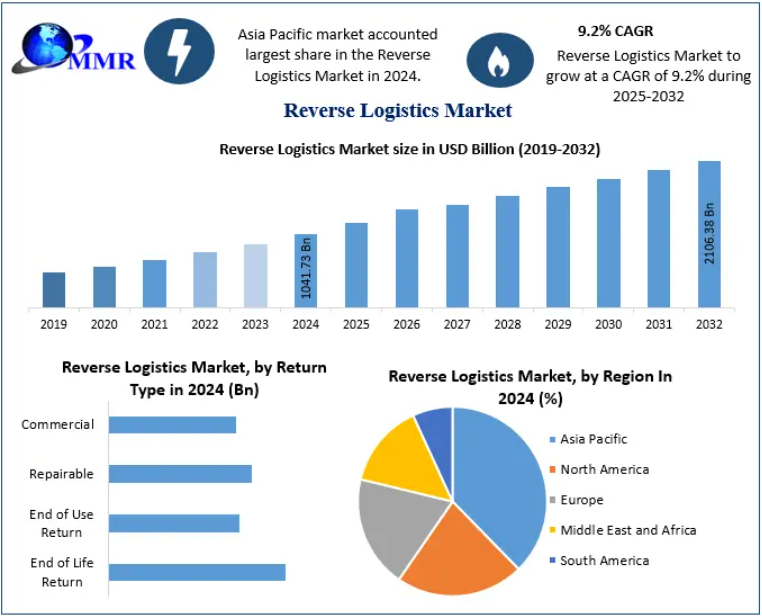Reverse Logistics Market: Global Growth Outlook and Forecast to 2032

Reverse Logistics Market: Global Outlook, Trends & Growth Opportunities (2025–2032)
The Global Reverse Logistics Market, valued at USD 1,041.73 billion in 2024, is projected to nearly double to USD 2,106.38 billion by 2032, expanding at a CAGR of 9.2%. As businesses worldwide shift their focus toward sustainability, operational efficiency, and customer-centric supply chains, reverse logistics continues to evolve as an indispensable component of modern commerce.
What is Driving the Reverse Logistics Market?
Reverse logistics involves the movement of products backward through the supply chain—from end users to manufacturers—for returns, repairs, recycling, refurbishing, or safe disposal. Growing environmental consciousness, regulatory pressures, and the explosive rise of e-commerce have significantly accelerated the adoption of reverse logistics systems.
To know the most attractive segments, click here for a free sample of the report: https://www.maximizemarketresearch.com/request-sample/30014/
Key Market Drivers
1. Rising Environmental Awareness & Government Regulations
Many countries have implemented strict guidelines related to product recycling, safe disposal, and circular economy practices. These regulatory frameworks—especially across automotive, electronics, and consumer goods sectors—are propelling businesses to deploy efficient reverse logistics processes.
2. Surge in E-Commerce Returns
With online shopping becoming mainstream, product returns have skyrocketed. Efficient return management, replacement handling, and refund processing have become critical for customer satisfaction, pushing e-commerce giants to adopt advanced reverse logistics operations.
3. Growing Automotive Recalls and EV Battery Recycling
The automotive sector faces frequent recalls involving defective components. Additionally, the global shift toward electric mobility has increased the focus on EV battery recycling, creating lucrative opportunities for reverse logistics providers.
4. Technological Advancements: Blockchain & Digitalization
Blockchain is transforming reverse logistics by enabling:
- Transparent product tracking
- Automated billing
- Lifecycle visibility from production to disposal
Companies like Walmart Canada have already implemented blockchain to streamline freight operations, demonstrating the transformative industry potential.
Market Challenges
Despite its growth trajectory, the reverse logistics ecosystem faces some barriers:
- Limited manufacturer control when outsourcing to third-party logistics (3PLs)
- Risks of data breaches, as confidential customer information is shared externally
- Lack of alignment between strategic goals of logistics providers and manufacturers
- Inadequate warehouse visibility, affecting product quality control
These factors may restrain the speed of reverse logistics adoption in certain industries.
Reverse Logistics Market Segmentation
By Return Type
- End-of-Life Returns (Dominant Segment)
Driven by product recycling and sustainability initiatives. - End-of-Use Returns
- Repairable Returns
- Commercial Returns
- Others
By End Use
- E-commerce (Largest Segment)
Fastest-growing thanks to high return rates and customer-centric policies. - Retail
- Automotive
- Electronics
- Pharmaceutical
By Service Type
- Transportation
- Warehousing
- Reselling
- Replacement Management
- Refund Authorization
- Others
To know the most attractive segments, click here for a free sample of the report: https://www.maximizemarketresearch.com/request-sample/30014/
Regional Insights
1. Asia Pacific – Market Leader with 53% Share
APAC is the fastest-growing region due to:
- Rising e-commerce penetration
- Expanding manufacturing hubs
- Growing EV adoption
- Increased need for “returns-ready” logistics models
Countries such as China, India, Japan, and South Korea dominate regional growth.
2. Middle East & Africa – Fastest Emerging Market (CAGR 12.9%)
Growing digital adoption, expanding logistics hubs, and rising consumer spending power make MEA a highly attractive region for market entrants.
3. Europe & South America – Strong Opportunity Zones
Established environmental regulations in Europe and developing e-commerce infrastructure in Latin America offer significant expansion potential.
Competitive Landscape
The reverse logistics market is characterized by strong competition, with global and regional players investing in automation, digital systems, and strategic partnerships.
Key Players Include:
- DB Schenker
- Deutsche Post AG
- FedEx Corporation
- Kintetsu World Express
- UPS
- Delhivery
- Yusen Logistics
- RLG Systems AG
- Safexpress
- Ecom Express
- Shadowfax
- Shiprocket
- Xpressbees
- Bluedart
- TCI Express
- First Flight Couriers
- Bizlog
These companies continue to innovate and expand capabilities to handle increasing reverse logistics demands driven by e-commerce and sustainability obligations.
Conclusion
The global Reverse Logistics Market is undergoing rapid transformation due to the surge in product returns, sustainability pressures, technological advancements, and the booming e-commerce sector. As businesses increasingly adopt circular economy practices, reverse logistics will evolve into a strategic advantage—reducing costs, maximizing product value, and supporting responsible consumption patterns.
Companies that invest in automation, digital supply chains, and data-driven return management solutions will emerge as leaders in this high-growth market.
- Art
- Causes
- Crafts
- Dance
- Drinks
- Film
- Fitness
- Food
- Jogos
- Gardening
- Health
- Início
- Literature
- Music
- Networking
- Outro
- Party
- Religion
- Shopping
- Sports
- Theater
- Wellness

